Following on from their exploration of Jerusalem, Jim and Karen continue to Jordan, where visiting Petra, the ancient city carved into rock, proved to be a truly incredible experience.
Petra – the name of a city that has intrigued me for years. Visiting Petra was one of the must-do “big rocks” in our travel plan. When setting up the visit into Petra and Jordan itself, we decided that using a travel agent to organise the trip would be the best bet. Getting to and crossing the border can potentially be a bit of a mission, according to all accounts. Being part of a tour helps, so we opted to have this section organised by professionals.
As it turned out for us on the day it was a doddle. A combination of crossing through from Israel to Jordan on a Saturday (Shabbat) was a help, being there at 8am in the morning when the border post opens was another help, and crossing at the southernmost crossing point just outside Eilat also helped as this crossing point is particularly used to tourists.
Top Tip for Visiting Petra: Get the Jordan Pass
Jordan normally has a visa entry fee when you arrive. If, however, you are staying for longer than a couple of days you are best to purchase what’s called a “Jordan Pass”. This must be purchased online before you arrive in the country. What it gives you is an entry visa, admission to Petra, plus admission to a host of other sites within Jordan. So depending on your plans and what you want to see, Google the Jordan Pass before you leave home. It’s a cost effective option.
We crossed the border on Saturday morning with a little help from the tour company reps we were with. We were then transported by our driver to our first scheduled stop at Wadi Rum, for our first taste of Jordan’s desert, via a three hour 4WD trip.
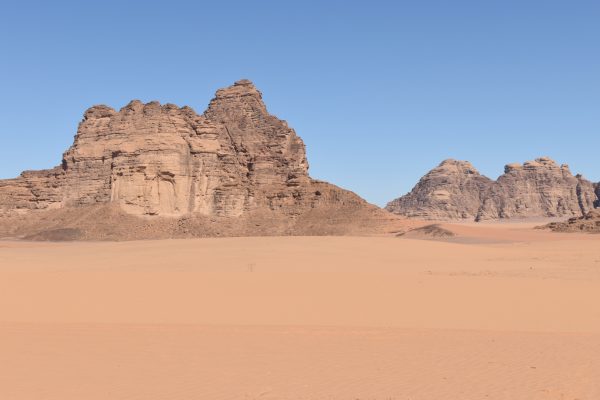
Wadi Rum, aside from being spectacularly beautiful, was the location and area where the real “Lawrence of Arabia” operated in WW1, as well as the location used to shoot the film in 1962.
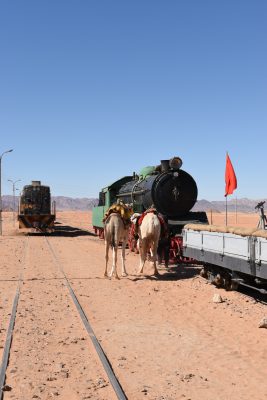
Since then a host of other films have used the area as their backdrop, including The Martian, two of the Star Wars movies, a Transformers movie and a host of others. The area offers plenty of tourist opportunities including staying the night to view the stunningly clear night sky and experience Bedouin culture.
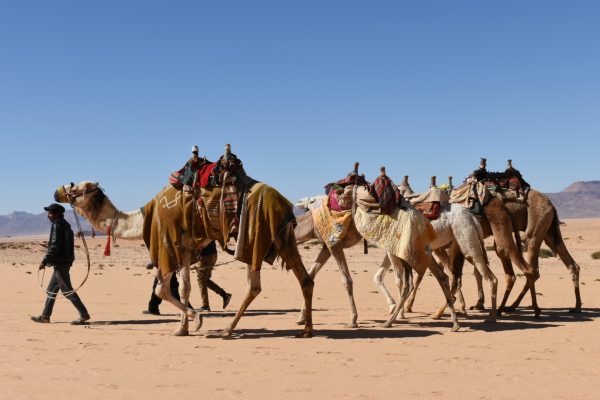
We had chosen to move through to Petra rather than stay in Wadi Rum, because I wanted as much time as possible there.
Because we were visiting in February there were few tourists in Jordan and the Middle East as it’s their winter. But in comparison to Europe at this time the weather was sunny, warm and I reckon it’s a great time to visit as you avoid the crowds. Consequently we had a driver guide all to ourselves who effectively became our private driver as part of our package. Haytham was our man and he was outstanding with very good English and a wealth of knowledge about his country. The drive from the border via Wadi Rum to Petra took about two hours in total so we had plenty of time to talk and for him to educate and enlighten us. Mike and Sandy have his contact details if you want to be hooked up with a top notch guide – I recommend him.
Petra is the number one tourist spot in Jordan and with tourism being their main income earner it is vital to the economy. But first a little history. The area has been inhabited by man seemingly forever. But supposedly around 5-600 BC the Nabataean tribe came and took over the area. The place we now know as Petra is located in a valley among a very rocky, hilly area in the middle of this vast desert area.
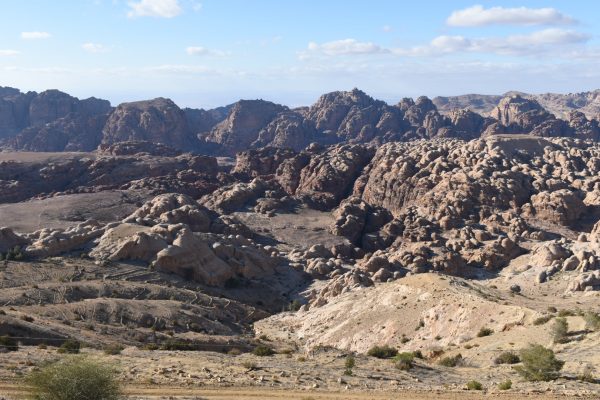
Under Nabataean influence this became the main thoroughfare for the trade caravans that criss-crossed the trade routes between Asia, Egypt and Greece in times past. The Nabataeans were first class traders, artisans and engineers and used their wealth and dominance in this area to eventually create and carve and decorate their capital city out of the surrounding rock. They were literally cave dwellers carving their homes and buildings into the sandstone cliff faces. It is estimated that at the height of their powers around 100 BC there were over 20,000 inhabitants living in this city alone, and more in the surrounding areas. The constant stream of traders and visitors passing through Petra over the years influenced the carving styles they created and so there are mixtures of Egyptian, Greek and Roman influences to be seen in their work.
To survive in any desert the big thing required is water, and this is where the Nabateans excelled. This desert area gets rain only a few times each year and it had no localised springs from which to source necessary water. So to survive they designed and then carved rain water run off collection channels around all the surrounding hills to channel any rain water into vast cisterns for storage. The cisterns themselves they carved into the hills as well. One cistern we visited was accessed via a small opening literally in the side of a hill. The inside had been tunnelled out and turned into a huge water storage tank capable of holding over a million litres of water.
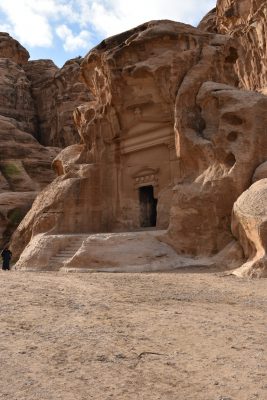
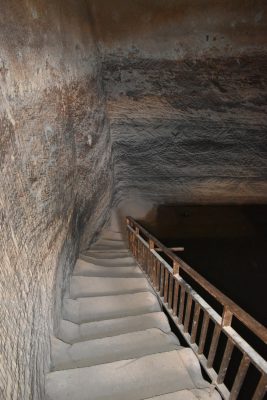
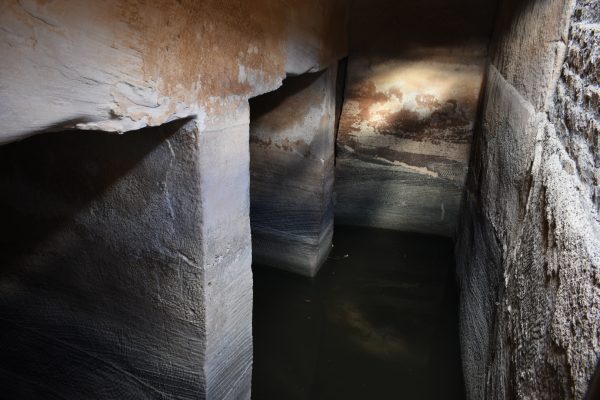
This was just one of hundreds dotted around the hills. They even developed a waterproof plaster to line the sandstone walls to make them watertight and minimise water loss.
The Nabataeans controlled this vast area and the trade routes till around 100 AD when finally the Romans decided they wanted to control this patch. Over the following years the area was captured and inhabited by many armies, including during the period of the Crusades to the Holy Lands. In more recent times the area has been inhabited by descendants of the Nabataeans, the local Bedouin tribe. The locals still lived in the caves in the area right up till the late 1970s and early 1980s, when the government and UNESCO realised how important the site is. In an effort to preserve the site they created and built special Bedouin villages in the area in an attempt to move the locals out of the main part of Petra. As a result nearly everyone living and working in and around Petra is of Bedouin ancestry, and the tourism to Petra provides their livelihood. There are, however, still a number of Bedouin who refuse to be rehoused and live as their ancestors have in the caves and tents dotted around the area.
Nowadays when you visit Petra it is a tourist hotspot and the locals are well versed in trying to extract every dollar and dinar from visitors. You walk down into Petra via its only road and very quickly it narrows into “The Siq”, a narrow descending road passing between towering cliffs.
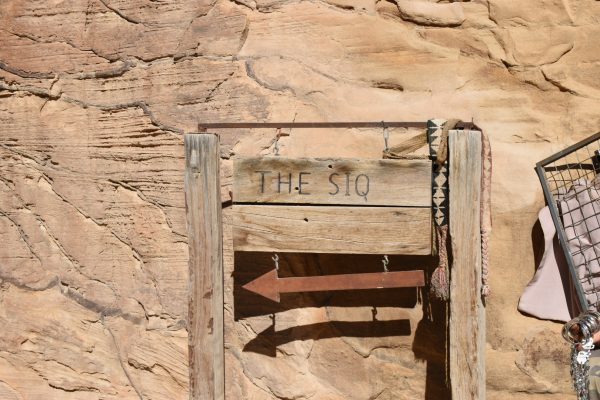
Today you needn’t have to walk along this 2-3 km winding track as there are donkey, horse, camel and carriage riders just waiting to take you a small part of the way.
Seems the horses pretty much have the first kilometre or so tied up…
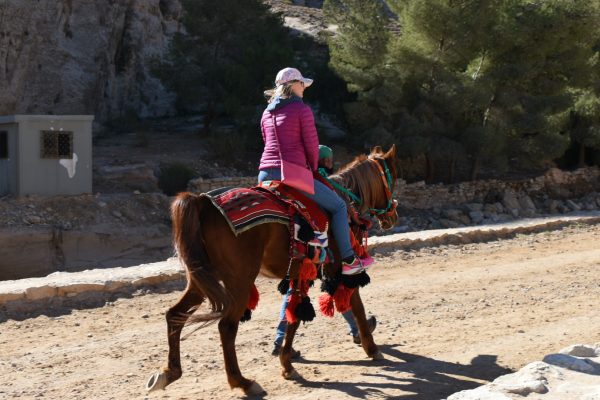
…then the carriages dominate the Siq.
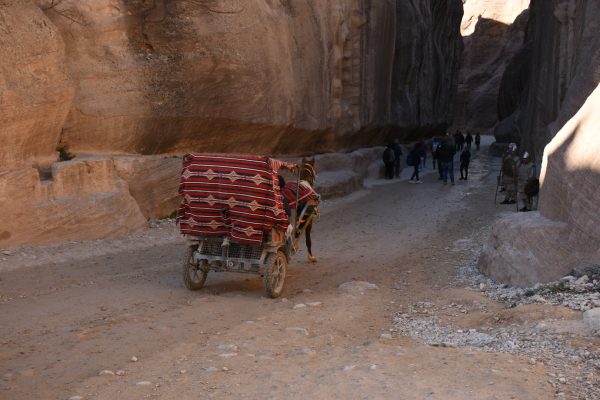
Camels stay around the main attraction sites for the photo opportunities as they are really too big for the Siq now with all the tourists walking through.
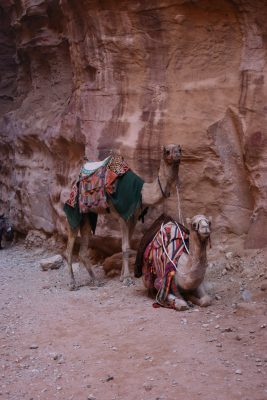
Meanwhile the donkey operators seem to cover all the steep trails and anywhere else a donkey wants to go.
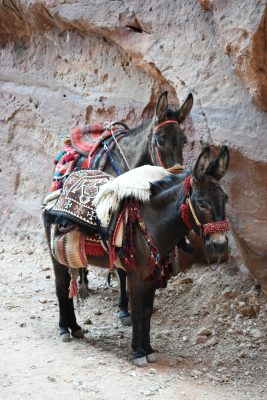
Now these guys are slick, and they seem to operate as a group. When you arrive at the start of the site, if you are not interested in hiring them for a ride in, they then tell you the ride is free and included as part of the admission ticket price. Then once you are onboard they tell you you should tip them otherwise they can’t eat. So being a good guilty tourist you offer 2 dinar tip and they then ask for 5. If you offer a 5 dinar tip they ask for 10. If you offer a 10 dinar tip they ask for 20.
They have it down to a fine art and it’s a pleasure to watch. If you haven’t guessed the rides are not included in the admission price. This is just their version of the old “why not take the car for a test drive” trick. Once you are on the beast you are going to shell out some guilt money. It’s just a question of how much.
The best however are the kids hustling and selling everything from rides to postcards to trinkets. They can spot a tourist at 100 paces and zero in with a lovely “hello welcome to Petra. Where are you from?” If you say France, they switch to French for their pitch, or to Italian, English, German, Spanish, and Arabic of course is no issue. Most it seems are fluent in about six languages, enough to extract a few dinar from you. It is a hoot to watch. The pitches all these guys make are very good. A regular one for us, when we were walking was this:
“Mister do you want a donkey/horse/camel ride?”
“No thanks we are happy to walk.”
“But madam has shorter legs she would appreciate a ride cause she has to walk further than you. Madam wouldn’t you like a ride?”
It is classic stuff – all nice and friendly because they have plenty of other punters to pitch rides at if you are determined to walk. So you walk the 2km road through the Siq.
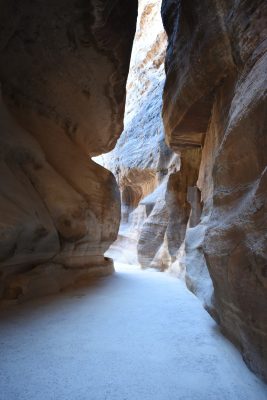
Each side has the remnants of the carved water channels that used to carry water down into the city and you start to realise how well designed this city was.
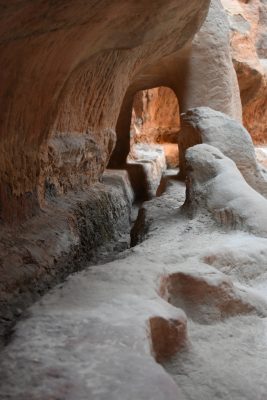
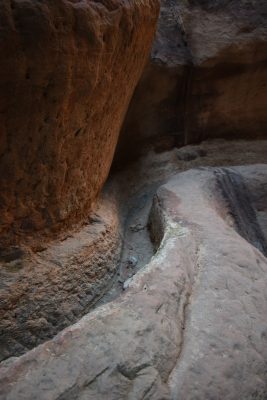
Suddenly you get your first peak at the “Treasury”, one of the most well-known structures in Petra thanks to an Indiana Jones sequel the Temple of Doom.
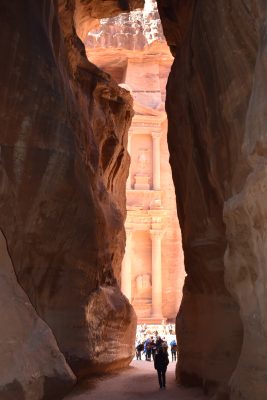
What a stunning structure it is. What a lot of people may not realise is that these facades are solid carved rock. They are not individual carved stone blocks stacked on top of each other. To accomplish these facades the builders/carvers had to start at the top and work down, that way rock that was being removed didn’t damage work below. It is just amazing when you think about it.
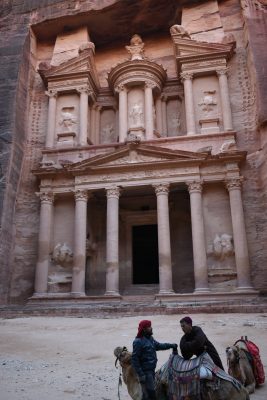
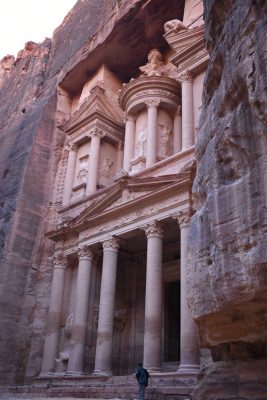
In all fairness photos don’t do justice to this place. Visiting Petra lived up to and exceeded all my expectations. I can only recommend you put it on your bucket list.
Be prepared for a walk if you intend to visit (unless you use the donkeys all the time). It involves climbs and steps to get anywhere. A stroll along the canyon floor will still give you great views of a lot of the area, however.
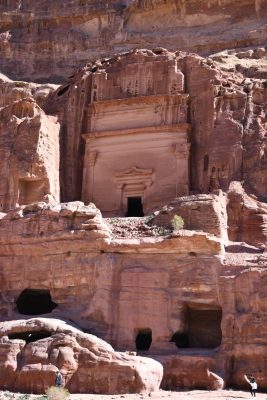
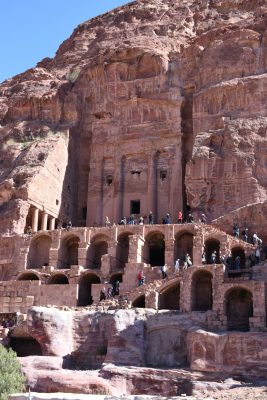
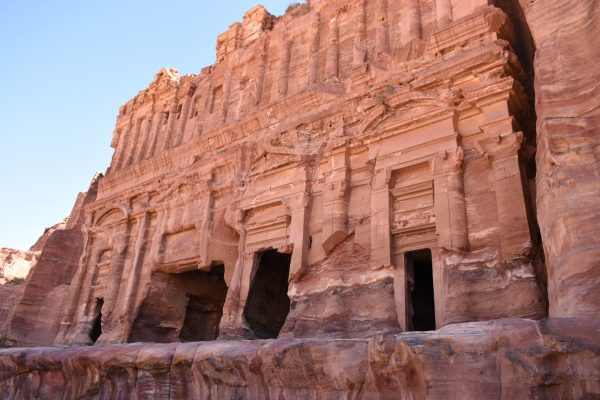
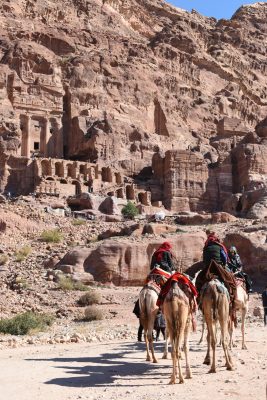
Two sites in particular involve a few more steps than other sites. Now in all fairness you can still get donkey rides up to these spots, but I reckon based on the steps and their steepness a donkey ride in itself would be a frightening experience. One such site is the High Place of Sacrifice (the name says it all really). You guessed it – it’s up high. But it offers fabulous views and is worth the climb.
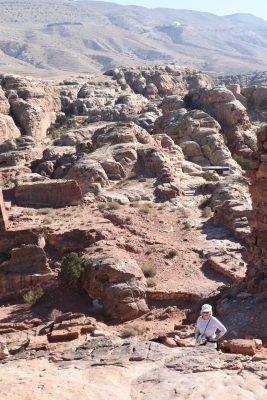
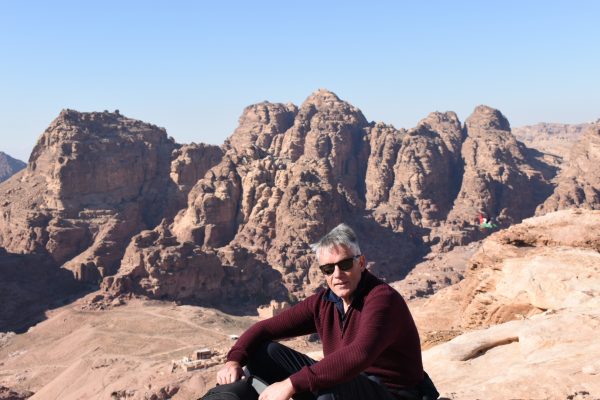
The second place is the “Monastery”.
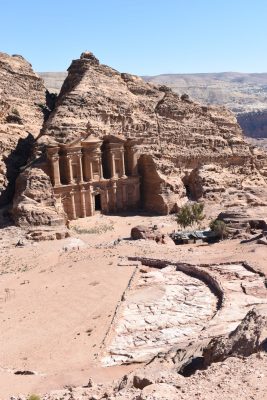
This is the largest and most stunning structure at Petra, even better than the Treasury. But not everyone makes the effort to climb to the Monastery either because it involves over 900 steps or they don’t have time.
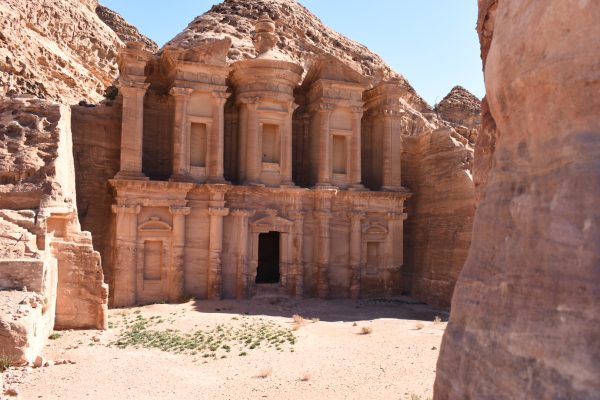
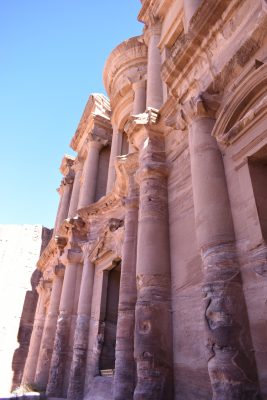
Top Tip for Visiting Petra: Stay the Night
Most people visiting Petra are on regular “in and out” day tours from somewhere so do not have enough time to see the main attractions as well as walk to the Monastery and or High Place of Sacrifice. It might be possible if you are an Olympic athlete, however the average Joe will have no chance. To do these two sites as well as the main attractions you really need to be overnighting in Petra so you get a full day minimum to get around. Amman to Petra is three hours and Aqaba to Petra is about the same. So my advice is don’t rush Petra, make sure you have a minimum of one complete full day to visit so you get to see the best. Karen and I spent a full seven hours on our first day looking at the main Petra sites and the High Place of Sacrifice. Because this visit was to be such a highlight for me we had booked two nights staying in Petra.
This allowed day 2 for us to be an organised “Back door hike into the Monastery”. This hike requires a guide and comes in from a different direction into the Monastery.
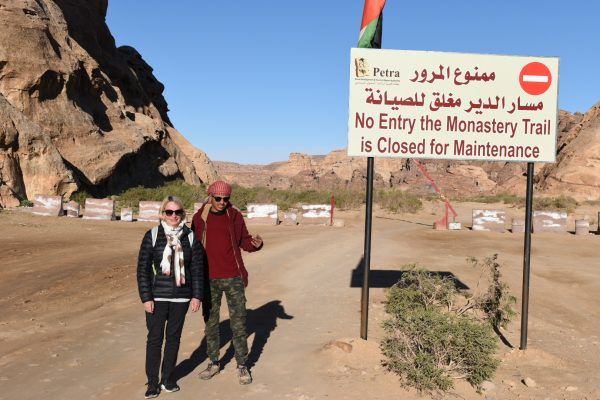
Got to say it was a great hike. It requires a bit of fitness but it is well worth the effort. Our guide was a local 18 year old Bedouin youth with good English and a great personality. He had all the usual patter, and couldn’t believe how old we were. According to him all the local 60 year olds are sitting in rocking chairs….yeah yeah…. But you have to love these guys, they have the scripts down pat.
Anyway the hike is a stunner if you can factor this into your travels do it.
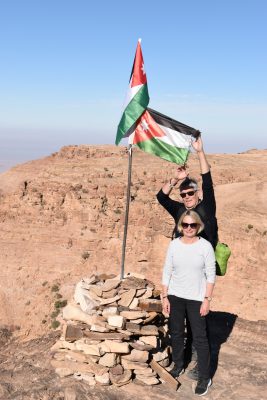
The end point is of course the Monastery, where you get to see the best site in Petra. Luckily this is the one time you are pleased to see the souvenir and trinket vendors at the end of the hike, because that means you can get a coffee or cold drink and the coffee spot doesn’t disappoint.
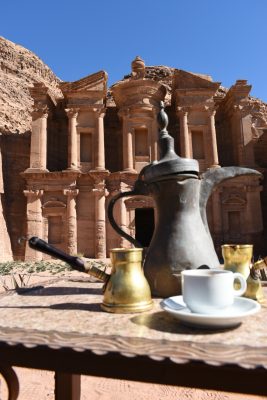
The walk back follows the normal path that all the other tourists use to get to the Monastery. Back down the 900 steps into the main part of Petra and back through the Siq to our hotel.
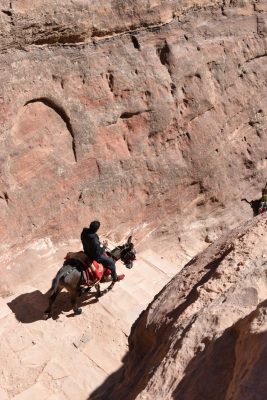
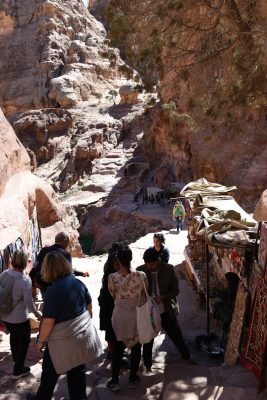
The whole two full days we spent in Petra, were right up there for me. It is a place I will never forget and I can’t recommend it enough.
But we couldn’t stay there forever, so Haytham our driver was back again to pick us up and deliver us to Amman. Driving in Jordan is a treat or maybe that should be threat. I have no idea why the roads have lane markings because no one pays any attention to them! They seem to think a painted lane marker should be in the middle of the car. Obviously indicator usage is banned in this part of the world, and when driving towards another vehicle the first man to cross back over the centre line onto their side of the road is a wimp.
I got fined in NZ many years ago for straight lining a corner in the Hundalee’s near Kaikoura by our police. They would have a field day here in Jordan and NZ would have no more national debt to worry about. The driving here is atrocious, so take an organised tour transport to travel through this country then try and sleep so you can’t see what’s happening around you (although I have probably just ruined your chances of that).
We arrived in Amman safe and sound (Karen swears she didn’t look the whole three hour drive) and have checked into a stunning apartment hotel close to the city centre. Amman was a city I particularly wanted to visit. I’m not sure why, I just had this image of a modern thriving Arab city.
So how has it lived up to expectations?
Interestingly no two sites on Google have given similar population estimates. Wikipedia says 4 million, other sites say just over 2 million. Regardless this is a packed city. There is no subway type system for people to get around on. There is instead a bus and taxi based public transport system. Sounds good, except that traffic is horrendous. It seems everyone here has a car and I reckon they use them to get around. So even public transport moves very slowly. Further complicating all this is the fact that Amman is an old city built on and surrounded by seven hills. So in the older parts of Amman (which is most of it), streets are narrow, very hilly and steep. With so many cars in the city, people literally park them anywhere and everywhere further mucking up traffic flow. Rome has nothing on this place.
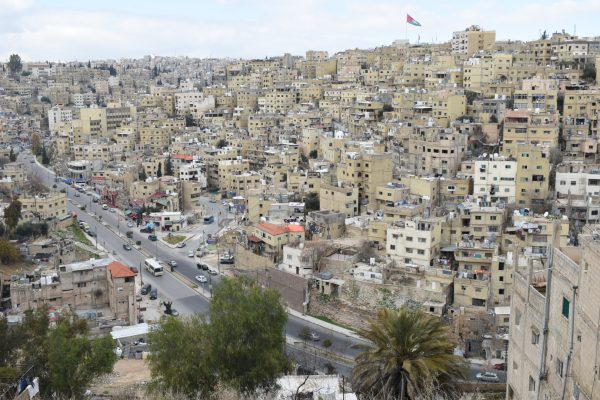
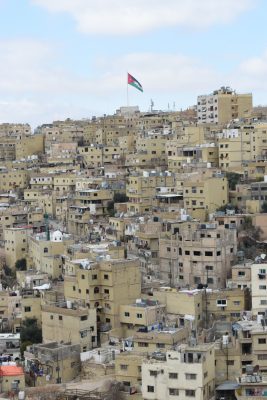
I reckon peak traffic flows here make the Auckland motorways and the M25 round London look like veritable racetracks, and the M25 is categorised as the biggest parking lot in the world.
As a visitor I would class Amman as a “hard city” to visit. A Paris or Rome it isn’t. It’s not a particularly “pretty city” in my opinion, but it is interesting and welcoming. No matter where you go people in the streets welcome you and thank you for visiting. Amman holds no concerns at all regarding personal safety or crime, and I can report having had the nicest meal in many many months in a local restaurant just last night. But be prepared to walk in this city, and I mean walk up steps and hills and down again. This would have to be the hilliest city I have ever visited. It’s not a problem as long as you are prepared and ready for it because sometimes walking is quicker than driving. Taxis are cheap over here, but you just have to make sure they turn on the meter.
We are staying in the area called Weibdeh, and as it turns out it would probably rate as one of the better areas to be in. It’s close to the downtown area, and as mentioned has some nice places to eat. So if you are planning on visiting Amman I recommend this location.
Overall we have really enjoyed our time in Jordan, and it should be a must see destination in the Middle East if you are coming over here.
For us now we move onto Egypt following a week here. I have to say this part of the world offers a lot, especially if you enjoy your history or are interested in following your religious roots.
Jim and Karen’s travels just keep getting better and better. Make sure you’re subscribed to our blog so you can follow on and get their latest updates as soon as they come through! And if you’ve been inspired to visit Petra, talk to the travel experts at World Travellers Riccarton – they’ll hook you up.

